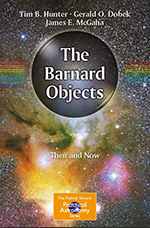Grasslands Observatory (original) (raw)
Grasslands Observatory Barnard Objects: Introduction
Now Available
The Barnard Objects - Then and Now
Dark nebulae are very common throughout the Milky Way. E.E. Barnard (1857-1923) is credited along with Max Wolf (1863-1932) with the first comprehensive study of these regions and with discovering dark nebulae are not holes in the Milky Way but obscuring interstellar dust clouds.
Dark nebulae in the Milky Way from our perspective range in size from less than one arcminute to many degrees. Similar dust clouds are quite common in other galaxies.
Barnard was a pioneering astrophotographer and cataloged a series of dark nebulae now known as Barnard Objects. Max Wolf at the University of Heidelberg also became a pioneering astrophotographer through his interactions with Bernard. They became life-long friends, and Wolf was very moved by the death of his dear friend Barnard in 1923. Barnard died in Williams Bay, Wisconsin, the home of Yerkes Observatory, and was buried in Nashville, Tennessee.
Barnard published his initial list of 182 dark nebulae in 1919 (Astrophysical Journal, January 1919; 49: 1-23). He gave them number designations from 1-175 with 44a, 67a, 83a, 84a, 117a, 119a, and 131a bringing the total objects to 182. After Barnard's death many examples of his astronomical photographs were published in 1927 as A Photographic Atlas of Selected Regions of the Milky Way edited by Edwin B. Frost, Director of Yerkes Observatory, and Mary R. Calvert, Barnard's niece. An online version of the book is available from The Georgia Institute of Technology.
A superb reprinting of this book was done in 2011 (Cambridge University Press, Cambridge, UK) under the direction of Gerald Dobek, a dear friend. I recommend it highly.
Frost and Calvert reprinted Barnard's 1919 list in the 1927 Photgraphic Atlas and included a second list which Barnard had started before his death. The positions of the dark nebulae for this second catalogue were determined by Mary Calvert, and this list was begun with #201 and ending at #370. Thus, there were originally no Barnard Objects having numbers from 176 to 200. These Missing Barnard Objects were added back to the Barnard Objects list by Dobek and Hunter in The Barnard Objects - Now and Then (Springer-Nature, 2023).
Frost and Calvert omitted #'s 52, 131a, and 172 from Barnard's original list feeling they had been mistakenly listed by Barnard twice. However, Dobek in his 2011 Photographic Atlas added those objects back stating: "This omission may have been in error." The fields in which these objects are situated are some of the most crowded in the sky. It would have been easy for Barnard to have mistakenly duplicated a listing; or, just as easily, Frost and Calvert could have mistakenly overlooked objects which Barnard had correctly listed. Dobek favors the latter interpretation, and with Dobek's 2011 editing, Barnard's catalogue consists of 352 dark objects. Barnard 52, 131a, and 172 are displayed on this site as described by Dobek in 2011. In addition, our added Barnard Objects 176-200 are also displayed on this site.
The present images of the Barnard Objects and other selected dark nebulae on this website were taken with a number of instruments due to the extraordinary range in size of the objects. Some of them are most suitable for wide-field telephoto lens imaging while others require the size scale and exposure possibilities provided by a telescope in the 20-24-inch range.
All of Barnard's original images were taken on black and white photographic plates. Color astrophotography was not practical until the 1960's when fast color photographic films became available. Today, all astrophotographic imaging is performed with digital cameras.
The images presented herein are in color, though the dark nebulae themselves are mostly shades of black and brown as would be expected from dust filled gas. However, the dark nebulae are often contrasted by nearby colorful stars or nearby emission and reflection nebulae with their extraordinary colors. Wherever possible, the instrument used and exposure data are provided for the images.
Unless otherwise noted all images are displayed with north at top and west to the right.
tbh 22 June 2016; revised 5 September 2023; revised 11 October 2023
Barnard Objects and other interesting nebulae:
Main | 001 - 060 | 061 - 120 | 121 - 180 | 181 - 240 | 241 - 300 | 301-370 | Top

